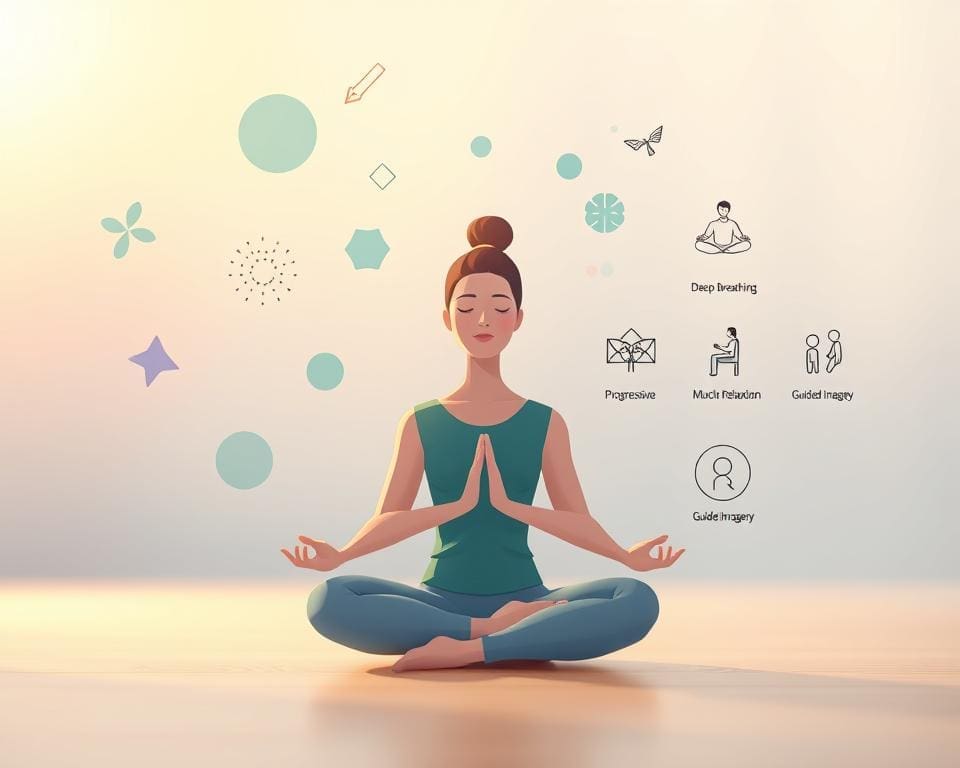In today’s fast-paced world, many individuals struggle with anxiety, seeking effective ways to cultivate a calm mind and enhance their mental wellbeing. Mindfulness techniques offer powerful solutions that not only provide anxiety relief but also foster emotional stability. By understanding and implementing these practices, one can significantly reduce anxiety symptoms and create a sense of tranquillity in daily life.
From mindful breathing to guided meditation, these techniques are designed to alleviate common triggers of anxiety and create pathways for mental clarity. Incorporating various mindfulness techniques into your routine allows for a transformative journey towards emotional health and serenity. For those interested in learning more about these impactful strategies, exploring further resources is a beneficial first step.
Understanding Mindfulness and Its Benefits
Mindfulness represents a practice that encourages the maintenance of a moment-by-moment awareness of our thoughts, feelings, bodily sensations, and our environment. Originating from Buddhist traditions, this approach has found a place in contemporary psychological therapies, enabling individuals to cultivate present moment awareness to enhance well-being.
What is Mindfulness?
At its core, mindfulness involves tuning into the present moment without judgement. This technique empowers individuals to observe their mental and emotional states, fostering a deeper connection to oneself. Through practices such as meditation and breathing exercises, individuals learn to embrace their experiences, paving the way for numerous mental health benefits. Developing a routine that includes mindfulness can be transformative, particularly for those struggling with anxiety management.
The Role of Mindfulness in Mental Health
Research highlights mindfulness as a potent tool in managing various mental health disorders, especially anxiety and depression. Regular engagement in mindfulness practices has demonstrated the capacity to enhance emotional regulation and reduce stress levels. Individuals often report significant improvements in their ability to cope with life’s challenges, as mindfulness fosters resilience and encourages a more balanced emotional state. Embracing mindfulness can lead to profound changes, not just in mental health, but in overall quality of life.
What mindfulness techniques reduce anxiety?
Exploring mindfulness practices reveals a range of effective techniques specifically designed to reduce anxiety. These methods empower individuals to manage their mental wellbeing through conscious awareness and intentional focus. Techniques such as meditation, breathing exercises, and mindful movement form a solid foundation for effective anxiety reduction techniques.
Overview of Effective Techniques
Mindfulness practices offer a variety of strategies, each with unique benefits. Effective techniques include:
- Guided Meditation: Focused visualisation promotes relaxation and clearer thinking.
- Breathing Exercises: Techniques like diaphragmatic breathing enhance calmness and mindfulness.
- Mindful Movement: Activities such as yoga and mindful walking foster physical and mental awareness.
- Progressive Muscle Relaxation: Systematically tensing and relaxing muscles alleviates tension.
- Body Scans: By focusing on physical sensations, distractions can be cleared, aiding in deeper concentration.
How Mindfulness Techniques Address Anxiety
Mindfulness practices effectively alleviate anxiety by fostering self-awareness and emotional intelligence. Engaging in these techniques enhances the ability to manage challenging emotions without leading to distress. When individuals regularly apply coping strategies rooted in mindfulness, they significantly reduce the tendency to ruminate on negative thoughts. The process of integrating these techniques into daily life contributes to a calmer mental state, preparing individuals to confront life’s challenges with confidence.
Breathing Exercises for Anxiety Relief
Breathing exercises serve as powerful tools for managing anxiety and promoting mental clarity. Practising deep breathing can encourage relaxation and focus. Many individuals find that integrating these simple yet effective anxiety relief techniques into their daily routine enhances their overall well-being.
Deep Breathing Practices
Deep breathing techniques focus on harnessing the body’s natural ability to calm itself. Two of the most beneficial methods are abdominal and diaphragmatic breathing. Both techniques engage the diaphragm fully, allowing for deeper intake of oxygen. This process lowers the heart rate and reduces cortisol levels, promoting a state of calmness and clarity. Regular practice of these techniques can significantly improve emotional regulation and resilience against stress.
Box Breathing Technique
The box breathing technique is a structured method that involves four simple steps: inhale, hold, exhale, and hold again, each for equal counts. This rhythmic process not only soothes the nervous system but also enhances mental clarity and focus. Practising this technique can lead to significant reductions in feelings of stress, making it a valuable addition to any anxiety relief toolkit. Engaging in box breathing for just a few minutes can provide immediate sense of calm and focus.
Guided Meditation and Visualisation
Guided meditation serves as an invaluable tool for individuals seeking mental clarity and relaxation. This practice involves listening to audio or watching videos that lead participants through various meditation techniques, making it an ideal starting point for beginners. Many find that guided sessions not only enhance relaxation but also effectively aid in managing anxiety. It is through these structured experiences that one can navigate the meditation process with greater confidence and ease.
What is Guided Meditation?
At its core, guided meditation provides direction and inspiration, allowing individuals to immerse themselves fully in the experience. This form of meditation invites practitioners to focus on their breath, physical sensations, or specific visualisations while being gently led by a narrator. Popular examples of guided meditations include those designed for stress relief, sleep, or body awareness. Participants often report remarkable improvements in their emotional well-being following these exercises, highlighting the effectiveness of this approach in fostering a tranquil state of mind.
Creating a Personal Visualisation Practice
Visualisation constitutes a powerful aspect of guided meditation, allowing the mind to explore serene landscapes and empower emotional healing. To establish a personal visualisation practice, begin by identifying calming imagery that resonates with you. This could be a beautiful beach, a peaceful forest, or any environment that evokes a sense of safety and tranquillity.
- Start with a brief guided meditation to ground your thoughts.
- Close your eyes and take a few deep breaths, allowing your body to relax.
- Visualise your chosen landscape, immersing yourself in every detail.
- Consider how you feel while visualising this place, allowing the sensations of calm to wash over you.
Regular practice of visualisation during guided meditation can transport your mind away from stressors, ultimately contributing to anxiety reduction. As you develop this skill, you may discover that these mental journeys enhance your overall well-being, providing a refuge from daily pressure. For additional resources on effective meditation techniques, explore this link.
The Power of Body Scanning
The body scanning technique serves as a profound mindfulness technique aimed at enhancing awareness of physical sensations while promoting complete body relaxation. This method invites individuals to tune into their bodies, fostering a gentle relationship with their feelings. Practitioners focus on observing sensations without judgement, allowing for a deeper understanding of both tension and relaxation throughout the body.
Understanding the Body Scan Technique
To embark on a body scanning journey, begin by lying comfortably in a quiet space where distractions are limited. Start by directing your attention to your toes, recognising any sensations present. Gradually work your way up through your legs, torso, arms, and head, taking the time to notice various feelings and thoughts that arise. This relaxation method enables individuals to cultivate a mindful perspective, enhancing overall emotional well-being. Research suggests that incorporating short moments of mindfulness, like body scanning, can effectively alleviate anxiety and improve focus.
How to Incorporate Body Scanning into Your Routine
Integrating body scanning into daily life can be straightforward and rewarding. Consider setting aside a few minutes each day for this practice. Choose a consistent time, such as in the morning or before bed, to establish a routine. Create a peaceful environment that encourages relaxation, perhaps with soft lighting and comfortable seating or lying arrangements. Regular practice of this mindful technique not only aids in reducing feelings of anxiety but also promotes emotional regulation. For insights on enhancing mindfulness practices, explore this helpful resource.
Mindful Walking and Movement
Mindful walking serves not only as a method of exercise but also as a potent form of meditation. Engaging in this movement practice allows individuals to create a connection between their thoughts, emotions, and the environment around them. Research indicates that this connection can significantly improve mood and reduce feelings of anxiety. By paying attention to each step, one can foster a sense of presence, transforming an ordinary walk into a meaningful experience.
The Benefits of Mindful Walking
Practicing mindful walking can yield numerous benefits, including:
- Improved focus and clarity
- Enhanced emotional awareness
- Reduction in stress and anxiety levels
- Greater connection to nature and surroundings
Each step taken mindfully creates an opportunity for self-discovery and promotes the essence of mindfulness in daily life. By immersing oneself in the simple act of walking, individuals can experience the beauty of the present moment in a profound way.
Incorporating Movement into Daily Life
Infusing mindfulness in daily life can be achieved through simple adjustments in routine movements. Consider these practical strategies:
- Practice mindful movements during chores, like washing dishes or sweeping the floor.
- Utilise transportation time, such as walking or cycling, as moments for reflection.
- Set reminders to pause and become aware of body movements during the day.
These techniques not only encourage a greater awareness of one’s body but also deepen the overall experience of daily activities. By consciously engaging in every movement, individuals can cultivate a deeper appreciation of their surroundings and internal states.
Utilising Journaling as a Mindfulness Tool
Mindful journaling serves as a powerful instrument for self-reflection and emotional clarity. Engaging in this practice allows individuals to capture their thoughts and experiences, aiding in the exploration of one’s mental state. Many people find that the journaling benefits extend beyond just documenting daily events; it provides a means of processing emotions and can be particularly effective for writing for anxiety relief.
Benefits of Mindful Journaling
Journaling can be a transformative practice, allowing for a deeper understanding of one’s feelings and thoughts. Through mindful journaling, individuals often uncover patterns in their emotions and develop insights that facilitate personal growth. Evidence suggests that this approach can reduce anxiety levels by offering a healthy outlet for expression. By regularly putting pen to paper, individuals can experience a sense of catharsis, promoting emotional well-being.
Prompts to Get Started
To encourage mindful journaling, consider using various prompts that inspire introspection. Here are some suggestions to ignite the writing process:
- Create a gratitude list that highlights three positive aspects of your day.
- Reflect on a recent challenge and describe your feelings surrounding it.
- Identify specific triggers that cause anxiety and explore their roots.
- Document a moment of joy, capturing the details surrounding it.
Regular engagement with these prompts can reinforce the benefits of journaling and contribute to sustained mental health advantages. The practice of mindful journaling not only enhances self-awareness but also fosters resilience in the face of life’s challenges.
Integrating Mindfulness into Daily Activities
Incorporating daily mindfulness into our lives involves bringing awareness to the simple yet profound moments that often pass us by. By shifting our focus to everyday practices such as eating, working, and socialising, we can create a mindset that nurtures mental wellbeing. For instance, when eating, take time to appreciate each bite, noticing textures and flavours, which fosters a deeper connection with food and promotes healthier eating habits.
Mindfulness can also be weaved into our professional lives, where stress often lurks. Approaching tasks with an intentional presence allows for more clarity and focus, transforming how we manage our workloads. Engaging fully in conversations, whether with colleagues or friends, also enhances social interactions, making them more meaningful and fulfilling.
When stressful situations arise, applying mindfulness techniques can be invaluable. Techniques such as pausing to breathe deeply or taking a moment to reflect can help create a buffer against stress. By integrating mindfulness into these daily activities, we cultivate a continual practice that not only enriches our present moments but also contributes to an overall sense of wellbeing. To explore guided mindfulness practices further, visit this resource for effective techniques that can easily fit into your routine.









